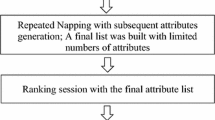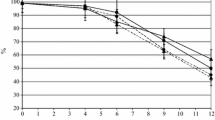Abstract
Yeast strain plays a central role in the formation of aroma and flavour of fruit wine. The effect of four commercial Saccharomyces cerevisiae strains (D254, VIC, BV818 and CECA) on volatile compounds of fermented pineapple (Ananas comosus L. Merr.) juice was investigated. Alcohols and esters were the most abundant groups in terms of the amounts of identified volatiles in four pineapple wines, followed by acids and sulphur compounds. Different S. cerevisiae strains possess various capacities to release or synthesize volatiles during pineapple wine fermentation. For global aroma, strain D254 yielded the highest total number and concentration of volatiles and could be used as a starter culture for the making of intense pineapple wine. Strain BV818 produced wine with the highest amounts of volatiles with OAVs > 1 and scored the highest in global aroma. Thus, BV818 might be the appropriate strain that could impart characteristic aromas and enhance wine complexity. The relative content of esters formed by strain VIC was higher than that yielded by the other strains. Strain CECA produced the highest relative contents of alcohols, aldehydes and ketones. However, VIC and CECA were not ideal starter cultures because of their low sense scores. This study provided a foundation for the production of pineapple wine with the desired flavour profile.




Similar content being viewed by others
References
Bamidele OP, Fasogbon MB (2017) Chemical and antioxidant properties of snake tomato (Trichosanthes cucumerina) juice and Pineapple (Ananas comosus) juice blends and their changes during storage. Food Chem 220:184–189
Chanprasartsuk OO, Prakitchaiwattana C, Sanguandeekul R, Fleet GH (2010) Autochthonous yeasts associated with mature pineapple fruits, freshly crushed juice and their ferments; and the chemical changes during natural fermentation. Bioresour Technol 101:7500–7509
Dellacassa E, Trenchs O, Fariña L, Debernardis F, Perez G, Boido E, Carrau F (2017) Pineapple (Ananas comosus L. Merr.) wine production in Angola: characterisation of volatile aroma compounds and yeast native flora. Int J Food Microbiol 241:161–167
Duarte WF, Dias DR, Oliveira JM, Vilanova M, Teixeira JA, Almeida e Silva JB, Schwan RF (2010) Raspberry (Rubus idaeus L.) wine: yeast selection, sensory evaluation and instrumental analysis of volatile and other compounds. Food Res Int 43:2303–2314
Feng Y, Liu M, Ouyang Y, Zhao X, Ju Y, Fang Y (2015) Comparative study of aromatic compounds in fruit wines from raspberry, strawberry, and mulberry in central Shaanxi area. Food Nutr Res 59:29290
García-Carpintero EG, Sánchez-Palomo E, Gómez Gallego MA, González-Viñas MA (2011) Effect of cofermentation of grape varieties on aroma profiles of la mancha red wines. J Food Sci 76:C1169–C1180
Hernanz D, Gallo V, Recamales AF, Melendez-Martinez AJ, Gonzalez-Miret ML, Heredia FJ (2009) Effect of storage on the phenolic content, volatile composition and colour of white wines from the varieties zalema and colombard. Food Chem 113:530–537
Iorizzo M, Macciola V, Testa B, Lombardi SJ, De LA (2014) Physicochemical and sensory characteristics of red wines from the rediscovered autochthonous Tintilia grapevine grown in the Molise region (Italy). Eur Food Res Technol 238:1037–1048
Jiang B, Zhang Z (2010) Volatile compounds of young wines from cabernet sauvignon, cabernet gernischet and chardonnay varieties grown in the loess plateau region of China. Molecules 15:9184–9196
Li W, Wang JH, Zhang CY, Ma HX, Xiao DG (2017) Regulation of Saccharomyces cerevisiae genetic engineering on the production of acetate esters and higher alcohols during Chinese Baijiu fermentation. J Ind Microbiol Biotechnol 44:949–960
Loscos N, Hernandez-Orte P, Cacho J, Ferreira V (2007) Release and formation of varietal aroma compounds during alcoholic fermentation from nonfloral grape odorless flavor precursors fractions. J Agric Food Chem 55:6674–6684
Ma L, Huang S, Du L, Tang P, Xiao D (2017) Reduced production of higher alcohols by Saccharomyces cerevisiae in red wine fermentation by simultaneously overexpressing BAT1 and deleting BAT2. J Agric Food Chem 65:6936–6942
Moyano L, Zea L, Villafuerte L, Medina M (2009) Comparison of odor-active compounds in sherry wines processed from ecologically and conventionally grown Pedro Ximenez grapes. J Agric Food Chem 57:968–973
Ndip RN, Akoachere JF, Dopgima LL, Ndip LM (2001) Characterization of yeast strains for wine production: effect of fermentation variables on quality of wine produced. Appl Biochem Biotechnol 95:209–220
Nyanga LK, Nout MJ, Smid EJ, Boekhout T, Zwietering MH (2013) Fermentation characteristics of yeasts isolated from traditionally fermented masau (Ziziphus mauritiana) fruits. Int J Food Microbiol 166:426–432
Perestrelo R, Fernandes A, Albuquerque FF, Marques JC, Câmara JS (2006) Analytical characterization of the aroma of Tinta Negra Mole red wine: identification of the main odorants compounds. Anal Chim Acta 563:154–164
Pino JA, Queris O (2010) Analysis of volatile compounds of pineapple wine using solidphase microextraction techniques. Food Chem 122:1241–1246
Roda A, Lucini L, Torchio F, Dordoni R, De Faveri DM, Lambri M (2017) Metabolite profiling and volatiles of pineapple wine and vinegar obtained from pineapple waste. Food Chem 229:734–742
Rodríguez ME, Lopes CA, Barbagelata RJ, Barda NB, Caballero AC (2010) Influence of Candida pulcherrima Patagonian strain on alcoholic fermentation behaviour and wine aroma. Int J Food Microbiol 138:19–25
Steingass CB, Grauwet T, Carle R (2014) Influence of harvest maturity and fruit logistics on pineapple (Ananas comosus [L.] Merr.) volatiles assessed by headspace solid phase microextraction and gas chromatography-mass spectrometry (HS-SPME-GC/MS). Food Chem 150:382–391
Steingass CB, Langen J, Carle R, Schmarr HG (2015) Authentication of pineapple (Ananas comosus [L.] Merr.) fruit maturity stages by quantitative analysis of γ- and δ-lactones using headspace solid-phase microextraction and chirospecific gas chromatography-selected ion monitoring mass spectrometry (HS-SPME-GC-SIM-MS). Food Chem 168:496–503
Sumby KM, Grbin PR, Jiranek V (2010) Microbial modulation of aromatic esters in wine: current knowledge and future prospects. Food Chem 121:1–16
Sun SY, Jiang WG, Zhao YP (2011) Evaluation of different Saccharomyces cerevisiae strains on the profile of volatile compounds and polyphenols in cherry wines. Food Chem 127:547–555
Swiegers JH, Pretorius IS (2007) Modulation of volatile sulfur compounds by wine yeast. Appl Microbiol Biotechnol 74:954–960
Velázquez R, Zamora E, Álvarez ML, Hernández LM, Ramírez M (2015) Effects of new Torulaspora delbrueckii killer yeasts on the must fermentation kinetics and aroma compounds of white table wine. Front Microbiol 6:1222
Zheng LY, Sun GM, Liu YG, Lv LL, Yang WX, Zhao WF, Wei CB (2012) Aroma volatile compounds from two fresh pineapple varieties in China. Int J Mol Sci 13:7383–7392
Zhu JC, Niu YW, Feng T, Liu SJ, Cheng HX, Xu N, Yu HY, Xiao ZB (2014) Evaluation of the formation of volatiles and sensory characteristics of persimmon (Diospyros kaki L.f.) fruit wines using different commercial yeast strains of Saccharomyces cerevisiae. Nat Prod Res 28:1887–1893
Acknowledgements
This study was financially supported by the Natural Science Foundation of Hainan province (Grant Number 317056) and the Scientific Research Foundation of Hainan University (grant number KYQD1660).
Author information
Authors and Affiliations
Contributions
XL carried out the experiments and drafted the manuscript. QKW participated in the wine fermentation and physicochemical properties analysis. XPH did PCA for the revised manuscript. WYW and YXZ participated in the analysis of volatiles. SXL and CFL conceived the study and reviewed the final manuscript. All authors read and approved the final manuscript.
Corresponding author
Ethics declarations
Conflict of interest
The authors declare no conflict of interest.
Electronic supplementary material
Below is the link to the electronic supplementary material.
Rights and permissions
About this article
Cite this article
Lin, X., Wang, Q., Hu, X. et al. Evaluation of different Saccharomyces cerevisiae strains on the profile of volatile compounds in pineapple wine. J Food Sci Technol 55, 4119–4130 (2018). https://doi.org/10.1007/s13197-018-3338-0
Revised:
Accepted:
Published:
Issue Date:
DOI: https://doi.org/10.1007/s13197-018-3338-0




